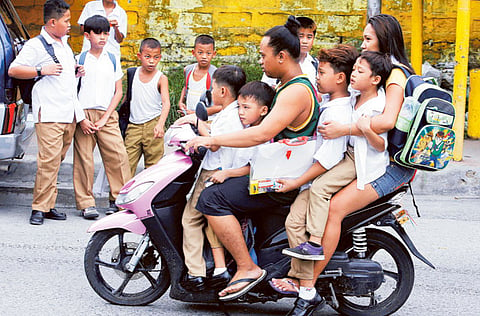Philippine schools race to deal with overcrowding
Free education in kindergarten, primary and secondary levels is causing challenges

Manila: The start of the school season has remained chaotic despite efforts by the Philippine government to meet the challenging demands of giving free education to a growing population of students in the kindergarten, primary, and secondary levels.
The Philippine government has already resolved classroom shortage in public schools’ first and secondary levels from 66,800 in 2010 to 32,900 this year. The construction of 19,500 more classrooms in one-storey story school buildings will be completed a month after the start of classes on Monday, education department’s Assistant Secretary Jesus Mateo said in an interview with ANC of ABS CBN.
“By 2013, we will be able to address shortages in classrooms,” Mateo said, adding that school lobby, library, or offices of the guidance counselor were already assigned as temporary classrooms, including several shifts of classes in several schools to accommodate a growing number of students.
Overcrowding of school rooms has remained due to the growing number of students beyond the expectation of the education department, Emmalyn Policarpio, secretary general of the Teachers Dignity Coalition, also told ANC.
There is a policy that public schools should not turn away parents who enrolled their children on the first day of school. “Parents are allowed to enroll their children up to two weeks after the start of classes,” said Policarpio, adding the real number of incoming students this year could be ascertained in two weeks.
A total of 20.6 million students were enrolled this year, 1.7 million are kindergarten students, 13.3 million, elementary students, and 5,7 million, high school students.
Many students who were formerly enrolled in private schools that were allowed to increase tuition fees, have transferred even earlier to public schools, resulting in bigger population in public schools, another source told Gulf News.
The 1.45 per cent increase of enrolled students from last year was due to the enrollment of new students in the kindergarten level, following the implementation this year the country’s K-12 Law, which calls for kindergarten education compulsory.
This could mean the education department could not yet reach its ideal ratio between student and teacher.
The education department hired of 33,900 teachers last February, on top of 35,000 volunteer teachers and 37,000 more teachers paid by local government units.
The government could not yet reach its ideal ratio of 1:25 ratio of teacher and students for kindergarten; 1:45 for elementary schools; and 1:50 to 55 ratio for high schools, said Luz Almeda, director of education department’s national capital region,
Five pe r cent or 35 schools in Metro Manila and other urban areas are congested, said Problems of shortage could affect number of seats and textbooks for students, said Almeda, adding that this problem is currently being solved with two to three shifts of classes per day.
Meanwhile, some 10,000 policemen joined the flag raising ceremonies in schools in Metro Manila, said National Capital Region Police Office (NCRPO) chief Director Leonardo Espina.
For a week, the education department has been announcing on TV and radio programmes that parents should not be coerced to pay anything for the enrollment of their children, following complaints that teachers with have been making illegal collection of fees from parents.
The education department has released hotlines, land-line (02) 636-1663 and mobile number 09194560027 for complaints.
“This is one problem we have to solve so that parents will send their children to school and take advantage of free education,” said Mateo.
Sign up for the Daily Briefing
Get the latest news and updates straight to your inbox



